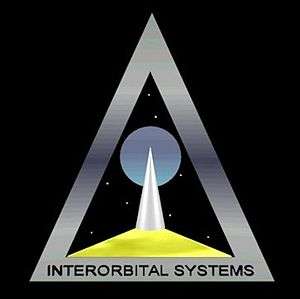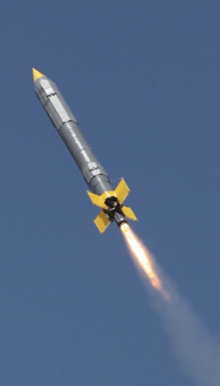Interorbital Systems
 | |
| Industry | Aerospace |
|---|---|
| Founded | 1996 |
| Headquarters | Mojave, California |
Key people | Rod Milliron and Randa Milliron (founders) |
| Products | Orbital rocket launch Commercial Orbital Transportation Services |
| Website | http://www.interorbital.com/ |
Interorbital Systems Corporation (IOS) is an American aerospace manufacturer active in Mojave, California. It was founded in 1996 by Roderick and Randa Milliron, who also co-founded Trans Lunar Research, a non-profit organization. They aim to develop simple, yet robust technology to be the lowest-cost launch provider in the commercial space industry.
Interorbital Systems is currently engaged in building a launch vehicle for the Google Lunar X Prize and for commercial launches. The company was also a competitor in the Ansari X Prize[1] and America's Space Prize.[2]
Current Products
Launch Services
- Interorbital Systems aims to launch payloads into orbit wholly from the sea using the NEPTUNE series of launch vehicles.
Satellite Kits
- CubeSat Personal Satellite Kit comes in both a standard 1 kg (2.2 lb) and a non-standard 1.33 kg (2.93 lb) configuration. Built of an aluminum frameDesigned for simple experiments, receiving and transmitting radio signals, or for personal use.
- TubeSat Personal Satellite Kit, a lower-cost alternative to CubeSats built wholly of printed circuit boards.
Both kits are launched into 310 km (192 mi) self-decaying orbits where they will eventually burn up in the Earth's atmosphere. Currently, they have a large launch manifest for both kinds of launches.[3]
Current Projects
Google Lunar XPrize
Interorbital Systems is currently engaged as a member of and launch provider for Team SYNERGY MOON in the Google Lunar XPrize competition.[4] The team's lunar rover will be lifted to the Moon's surface by a modified, 36-module version of the NEPTUNE rocket.
Research and development
Interorbital Systems current development focus is on its NEPTUNE line of launch vehicles.
Common Propulsion Module
All of Interorbital's rocket designs are based on the Common Propulsion Module (CPM). The CPM is a small, self-contained rocket system capable of delivering a 145 kg payload to an altitude of 310 km. Multiple CPMs are combined through parallel staging to meet varying mission requirements. Though they have experimented with cryogenic fuel, Interorbital currently uses hypergolic White fuming nitric acid and Turpentine for oxidizer and fuel. The CPM is designed to maximize simplicity - it uses no turbopumps and no ignition system (because of the hypergolic propellants).[5]
Orbital spaceflight program
The NEPTUNE system is Interorbital System's flagship line of launch vehicles built from varying configurations of the Common Propulsion Module.[6]
There are currently four stable configurations:
- The NEPTUNE (N3) A three to four stage vehicle assembled from 3 CPMs with a maximum payload capacity of 18 kg.
- The NEPTUNE (N5) A three to four stage vehicle assembled from 5 CPMs with a maximum payload capacity of 30–40 kg.
- The NEPTUNE (N7) A four-stage vehicle assembled from 7 CPMs with a maximum payload capacity of 75 kg.
- The NEPTUNE (N36) A four-stage vehicle designed assembled from 36 CPMs with a maximum capacity of 1,000 kg or a 191 kg to Trans Lunar injection and 32 kg to the Lunar surface. A variant of this configuration will be used to deliver Team SYNERGY MOON rover to the surface of the Moon for the Google Lunar X Prize.
Lunar Sample Return Mission
The lunar sample return mission will excavate and return material from the Moon's surface using the company's own RIPPER Vehicle.
Sounding rockets
Interorbital Systems has successfully tested a number of rocket engines in the 500-5,000 lbf (2 to 22 kN) thrust range and conducted flight tests of its small testbed, Neutrino. Neutrino is a sounding rocket designed for low-altitude suborbital flight, for the purpose of testing systems of its larger follow-on rockets.
IOS holds an active Office of Commercial Space Transportation launch license for Tachyon,[7] a sounding rocket designed for a 120-mile apogee suborbital flight.
Preliminary Design Concepts
- Solaris: a suborbital rocket design that was initially IOS' attempt to win the Ansari X Prize. It did not get off the ground in time and was beaten by Scaled Composites' SpaceShipOne.[8]
- Sea Star SAAHTO (Stage And A Half To Orbit): The largest design. It could be fitted to carry either cargo or human passengers. To do so, a crew module has been designed. This space capsule is to be capable of housing five crew members and a pilot, and sits atop the Neptune TSAAHTO during launch. The rocket itself is composed of eight large common propulsion modules and eight small common propulsion modules and can place a 7,000-pound payload into a 250-mile 51° orbit.
Milestones

- The CPM's main engine underwent its first successful static engine firing on October 28, 2012. The all composite-chambered engine performed with 7,500lbs of thrust, using nitric acid and turpentine.
- The Common Propulsion Module Test Vehicle (CPM TV) performed its first successful test flight on March 29, 2014.[9] The payloads included two CubeSats, a SYNERGY MOON payload and "ENCLOSURE" by Red Hot Chili Peppers guitarist, John Frusciante.[10] The rocket reached an altitude of 10,000 feet and will be reused for the next test flight. All payloads were recovered intact, however were not released to orbit.[9]
See also
- Private spaceflight
- Orbital spaceflight
- Sub-orbital spaceflight
- OTRAG, which used a similar modular rocket design
- Mojave Air and Space Port
References
- ↑ "X PRIZE Team Summary Sheet: Interorbital Systems" (PDF). X PRIZE Foundation.
- ↑ Boyle, Alan (October 8, 2004). "Space racers set sights on orbital frontier: After X Prize, some rivals seek more lucrative payoff". MSNBC.
- ↑ "Launch Manifest". Interorbital Systems.
- ↑ "Lunar Missions_1". www.interorbital.com. Retrieved 2016-06-05.
- ↑ "Synergy Moon Presentation at 2011 GLXP Summit". YouTube. 2011-07-16. Retrieved 2013-08-11.
- ↑ "Launch Vehicles_1". www.interorbital.com. Retrieved 2016-06-05.
- ↑ Milliron, Randa (2006-05-28). "Advantages of Using White Fuming Nitric Acid (WFNA) as an oXidizer in Rockets". Lunar Lander Challenged. Retrieved 2013-08-11.
- ↑ "Space racers set sights on orbital frontier". MSNBC. 2004-10-08. Retrieved 2013-08-11.
- 1 2 https://web.archive.org/web/20140407090735/http://www.interorbital.com/interorbital_03302014_018.htm. Archived from the original on April 7, 2014. Retrieved May 6, 2014. Missing or empty
|title=(help) - ↑ "Album Launch: John Frusciante Sends New LP Into Space on Rocket". 2014-03-31. Retrieved 2016-06-27.